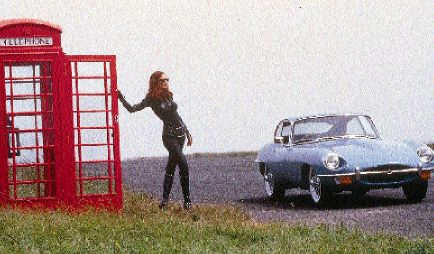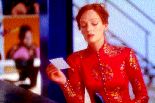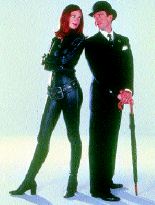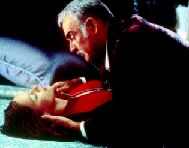
The Avengers
The film reviews have been damning, but the public has flocked to the cinemas regardless. Rob James investigates the quirky and shady regions of The Avengers sound world
The televisions series The Avengers began life as Police Surgeon with the late, great, Ian Hendry avenging his wife's murder. Patrick MacNee played a well-heeled, suave, debonair civil servant. When Hendry left to do a movie the series was renamed and the clipped tones of John Steed were joined by Honor Blackman as Cathy Gale. Blackman went on to do Goldfinger and Diana Rigg's Mrs Emma Peel took over as the series moved from black and white into colour, and brought dark catsuits and sharp brains. Rigg was succeeded by Linda Thorson, but MacNee remained until the series was dropped in 1969. It was revived as The New Avengers with Gareth Hunt and Joanna Lumley in support. In its time, The Avengers captured the imagination of audiences across the world.
Since every other similar UK TV series of any note seems to have spawned a movie--sometimes with dubious results--it is surprising it has taken until now for The Avengers to hit the big screen. But where the television plot lines tended toward the fantastic, and the movie is no exception both in plot and production, the director and dialogue writer seem to have missed the point. The TV series' were always tongue in cheek, but the characters had depth and there was real chemistry between them. In the film the leading characters are flatter than a surface plate and even Sean Connery appears to be on auto-pilot. The only vaguely sympathetic acting comes from the minor characters including the transparent archivist, a cameo role for Patrick MacNee as I (for invisible?)Jones. The spectacular weather and other visual effects not to mention the slick and involving mix sadly cannot redeem the rest.
The early TV episodes were broadcast semi live, and as the series progressed so did the production methods leading later episodes to be shot on film. Given the intervening technical advances, the film was edited by Mick Audsley on Lightworks with the majority of sound postproduction undertaken at De Lane Lea in the heart of London's Soho. Adrian Rhodes began working on The Avengers in October 1997, initially as effects editor and is currently best known for his sound design work on the Wallace & Grommit animations. Director Nick Park and Rhodes were at the National Film and Television School together. The high profile of Wallace & Grommit has slightly obscured the rest of Rhodes work which includes, lead mixer on The Full Monty and Hanif Kureishi's The Fanatic and effects editor on the latest Bond epic Tomorrow Never Dies. Danny Longhurst was dialogue editor, Ian Wilson did Foleys. The team shared two assistants, Guy Hake who, according to Rhodes, was also indispensable as the team 'boffin' and Mark Rose. This compact sound team illustrates the way digital tracklaying is revolutionising the business. If the tracklaying for a movie of this complexity is undertaken on 35mm magnetic film the number of people involved could be expected to at least double.
Location recording by Clive
Winter was on a standard 1/4-inch Nagra job with time code; although the
majority of the dialogue was replaced in ADR sessions due to the large
number of special effects intensive shots which rendered much of the location
sound unusable. The film rushes were transferred  to
Betacam, the sound synchronised and copied to the Beta tapes and sub master
DATs--all fairly routine stuff these days and caused few problems.
to
Betacam, the sound synchronised and copied to the Beta tapes and sub master
DATs--all fairly routine stuff these days and caused few problems.
By November the first of many temp mixes took place in De Lane Lea's Studio 5. This is one of the smaller theatres in the complex, equipped with an AMS Logic 2 console. These mixes are produced for a variety of reasons; to get an idea of whether the film is working, to help determine what dialogue needs replacing and to assist in designing the track. The dialogues were prepared on a Waveframe then digitally bounced to DA-88 since this was a delivery requirement. The DA-88 tapes were digitally bounced to Akai for mixing. ADR recordings were made in London, Shepperton and New York recorded on whatever the individual ADR theatres usually employ and then loaded into the Waveframe for editing. Foleys were recorded, edited and delivered on Akai (a DR16 in this case). Rhodes used his Spectral Synthesis Audio Engine for effects editing with the results digitally transferred to Akai for mixing.
It is generally considered
undesirable to mix for cinema in a small theatre, but Adrian Rhodes
reckons, 'We did the mix in Studio 5 because it was available and I am
used to the Logic. But to be safe we did the SVA (Stereo Variable Area,
a term used for a Dolby Stereo Matrix encoded master) in the much larger
Studio 3, and then checked the mix on one of the screens at the Warner
Village in Leicester Square. It was absolutely fine.' When Studio One
at De Lane Lea was designed, the decision was made to eschew rows of magnetic
film machines in favour of a bank of Akai DD8 digital dubbers. Akai machines
are also used as recorders in the other studios.
There were several subsequent temp mixes as editing progressed. This would usually require a complete remix or copying and editing of premixes but Rhodes found a better way, 'All the mixes were recorded onto Akai machines,' he explains, 'and we tried out the auto reconform that was introduced a while ago. It was a highly successful venture. Everything worked and we just had to fill the holes where new shots had been cut in.'
The effects gathering and creation started right at the beginning and continued throughout the postproduction period. 'Meanwhile I was adding to the effects,' Rhodes continues. 'I made heavy use of an E4 Emulator and SPL Vitaliser plus various Yamaha SPXs and Lexicons, but, really, it's just using a lot of imagination, you don't need to spend a fortune on toys to achieve results.
'The SFX shots were perpetually changing, background lightning hits would happen in different places. Things come and go, and you have to keep updating. At least on The Avengers we did get to see all the shots, on The Borrowers some shots we never did see and just had to make the best guess.'
The mechanical bees effects
were made from a variety of unlikely parts. 'An electric razor and
an electric toothbrush, Doppler shifted and pitched with the E-mu, and
I did find a simple way of achieving an organic bee  sound using a helicopter and single engined plane up and past with some
outboard pitch change courtesy of an Eventide. Mix that lot together and
you get some organic mechanical bees.'
sound using a helicopter and single engined plane up and past with some
outboard pitch change courtesy of an Eventide. Mix that lot together and
you get some organic mechanical bees.'
Many of the backgrounds are constructed from equally imaginative sources. 'I have a huge library of wind sounds, mostly mouth produced. Your mouth is a very versatile instrument for effects work. I am also the voice of the Prime Minister. I did it for one of the temp mixes and they kept it in.'
The score was to have been composed by Michael Kamen, but, if Warners is to be believed, due to the complexity of the visual effects, the film was late and Kamen had another booking that prevented him completing The Avengers. As a result Joel McNeely is the man responsible for the mighty score with its occasional well handled 'homage' to the TV theme. The music recording took place at Abbey Road with Shawn Murphy engineering and some programming done in the US. The resulting material was presented for mixing on Pro Tools 24 with a Genex backup that, in the event was never required. It is an interesting sign of the times that there was insistence on staying 24 bit with the music. How long will it be before 96kHz sampling or maybe even 192kHz becomes a production requirement?
The final mix was originally booked into Shepperton Sound, but, again due to the delays, it was eventually decided Adrian Rhodes would co-mix the film in De Lane Lea's Studio 1 with Mike Prestwood-Smith who had recently joined De Lane Lea from Goldcrest and brought considerable Harrison and Synclavier experience to the party.
'Being a Logic user I found the Harrison Series Twelve quite difficult to start with,' Rhodes recalls, 'but the learning curve was really quick because ultimately, it is a pretty standard console. It's just the automation which is tricky to begin with having learnt on a different desk with a processing pool rather than fully-loaded channel strips. There seems to be an automation mode on the Twelve to suit everybody.'
Standard maybe, but with a phenomenal number of inputs. 'When this desk was specified, 140 full channels seemed like overkill but on this film we used them all. On Reel 3, with the mechanical bees, and on the final reel we even had to use some pre-dub inputs as well. To make it as exciting as possible there are all the elements contributing, fire, wind and water.
'To leave things as open as possible the effects were premixed onto 32 tracks with monos, pan groups, two subs and two stereo surrounds. Foleys were mostly across 16 tracks, and there is a serious amount of Foley. This is a big effects movie.'
Dialogue premixes covered a further 16 tracks with monos, pan groups, split reverbs and subs with the music score coming direct from Pro Tools and 'source music' supplied on DA-88. The team used some fairly novel approaches to the final mix.
'We had the dream of doing a totally "virtual" mix, but the picture goalposts were moving to fast so we had to compromise. All the premixing and final mixing was recorded on Akai DD8s onto MO discs, so we never had to bother about disc clearing or archiving. The mixes were done "virtually" reel by reel. In other words, no audio actually gets recorded until the reel is complete then we transfer it to disk in one pass with the automation doing all the work. We even used the time-code automation of the Lexicon 300s to take care of reverb changes. It all behaved perfectly.'
The final mix was spread
across three DD8s split into Dialogue Effects and Music each with
LCR, Ls, Rs and S channels. The delivery requirements included mixes in Dolby SRD and the accompanying
SVA, DTS and SDDS.
delivery requirements included mixes in Dolby SRD and the accompanying
SVA, DTS and SDDS.
'We simply ignored the extra effects channels,' says Rhodes. 'This is okay with the SDDS people and to do anything else would have required a substantial remix.'
As a matter of interest, both the DTS and SDDS mixes were supplied on DA-88 tapes lending more proof to the ubiquity of the format. I live in hope a more robust disk-based format will supersede it. Meanwhile there are interesting lessons to be learnt by other manufacturers. In particular the relatively easy interchange between US and other time-code formats is one of the reasons for its success.
And the mix is, indeed, remarkably dynamic, clean and punchy. Every word of the dialogue can be heard without the usual strain and sensible use of the available dynamic range has allowed for real shocks.
'There is a bit of a sense around at the moment that effects levels are get ting too hot in all the digital formats at the expense of dialogue intelligibility and also safety. If the dialogue mix is right, using the available dynamic range is the key. Just because you can go loud doesn't mean you have to all the time. In fact, if you do, you lose impact.'
Rhodes regards the idea of working as effects editor and mixer on the same movie as 'a wonderful way to work, but uneconomic from a company point of view. But, if I am honest, I am a mixer at heart so that's what I now am.' After the recent change of ownership he is also a share holding director of De Lane Lea along with Paul Hamblin, Dave Old and Mike Solinger. They have some exciting development plans and it will be interesting to see them put into effect. The postproduction route(s) followed by The Avengers is a good indicator of where things are going. Virtual mixing is almost a reality and will open up a myriad of possibilities. Digital dubbing is coming of age. It is not only viable but offers huge advantages to facilities and producers alike, especially when the film is in an almost constant state of flux until the last minute.
Studio Sound oct 1998
>> Avengers